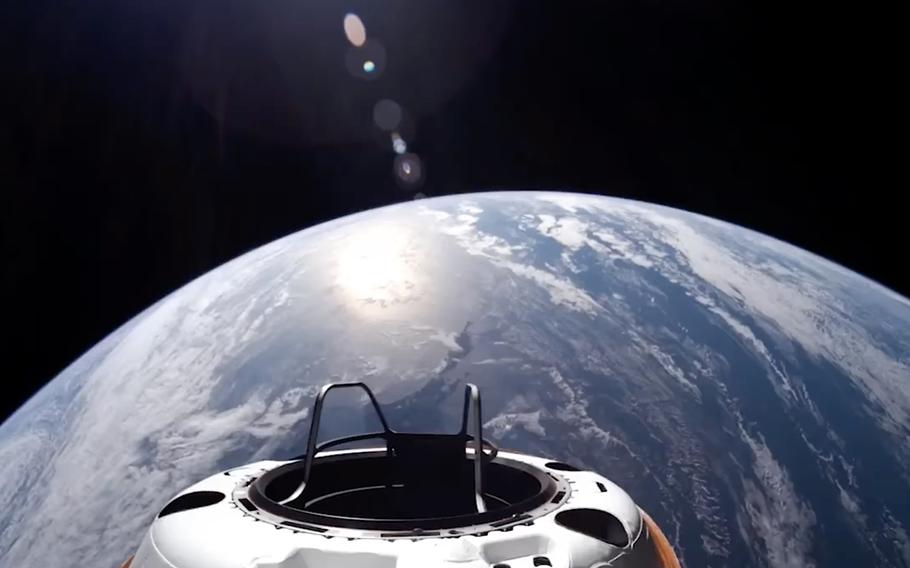
This image taken from the Crew Dragon Resilience on Sept. 11, 2024, during the Polaris Dawn mission shows Earth from nearly 870 miles altitude. (SpaceX/TNS)
ORLANDO, Fla. (Tribune News Service) — The four passengers on the Polaris Dawn mission that launched from Kennedy Space Center early Tuesday reached their goal of flying farther away from Earth than anyone since the last Apollo mission.
SpaceX early Wednesday posted video taken from Crew Dragon Resilience of the event that included the audio exchange from its mission control and Polaris Dawn commander Jared Isaacman, who is making his second trip to space as part of a five-day orbital mission in partnership with SpaceX to test out innovations for Elon Musk’s company.
That included a plan to take Dragon to a much higher orbit, and breaking the low-Earth altitude orbital record set by NASA astronauts Pete Conrad and Richard Gordon when they flew on the Gemini 11 mission at an orbital that reached 853 miles altitude. Apollo missions to the moon traveled farther from Earth, but on lunar trajectories and not part of a low-Earth orbit mission.
Crew Dragon Resilience reached nearly 780 miles altitude as part of six high-altitude elliptical orbits of the Earth before the capsule began a series of burns to lower its altitude to a safer region ahead of a planned spacewalk on Thursday.
“Dragon, you’ve soared to over 1,400 km and you’re farther from Earth than any other person since the last Apollo mission over 50 years ago,” said SpaceX mission command.
“Copy that SpaceX, we all look forward to our friends at the Artemis program to take us to ever greater heights,” replied Isaacman.
Isaacman shared the feat with his crewmates, former Air Force pilot Scott Poteet and SpaceX employees Sarah Gillis and Anna Menon.
Nine missions of the Apollo program including six that managed successful moon landings, took 27 astronauts, including three who flew two missions each, to farther distances.
The three astronauts of Apollo 13 hold the distance record for Earth during their aborted moon landing mission, traveling 248,655 miles from Earth as they passed on the far side of the moon.
Artemis II, which will take four astronauts on an orbital trip back to the moon as early as September 2025 in the Orion capsule, could break that record as it ventures 4,600 miles beyond the far side of the moon on its planned trajectory. Just how close the moon is the Earth will depend if Artemis II breaks that record as the moon can range from 221,000 to 252,000 miles away depending on the time of the month.
Musk posted a poem to X after the feat saying, “Strive to greater heights, For a future brighter than the past, Waking up each morning inspired, To learn new secrets of the Universe!”
The purpose of taking Dragon to such heights is subject the spacecraft and its human passengers to the harsher environment.
“That puts us just inside the Van Allen radiation belt,” Isaacman said earlier this year. “It’s an awesome opportunity for us to get some data. But really, it’s about kind of pushing beyond our comfort zone and where we’ve been at for the last 20 some odd years.”
The International Space Station orbits the Earth at about 250 miles.
“If we’re going to get to the moon, Mars and beyond, we have got to start venturing out a little bit farther,” he said.
Since SpaceX’s goal is eventually colonize Mars, Isaacman said exposing the spacecraft to the charged particles and higher radiation levels trapped by the planet’s magnetosphere will help inform human health science and research.
“If we get to Mars someday, we’d love to be able to come back and be healthy enough to tell people about it. So I think that’s worthwhile,” he said. “To get some exposure in that environment also informs vehicle architecture, because, generally speaking, vehicles don’t like radiation, so that’s why we’re going to stay there for the shortest amount of time that’s necessary to gather the data we want, and then we’ll come back down.”
The spacecraft is now heading to an orbit that will be at a maximum altitude on its elliptical orbit of about 470 miles.
That’s where the mission will tackle its biggest venture, the planned spacewalk during which Isaacman and Gillis will each venture outside the spacecraft for 15-20 minutes while connected with a 12-foot-long tether performing a series of maneuvers.
The spacecraft has no airlock, so the entire Dragon capsule will be vented of its atmosphere while all four crew members wear the new SpaceX extravehicular activity (EVA) spacesuits.
As part of the activity, the four have already been undergoing what the Polaris Dawn team has said is a “pre-breathe protocol,” which over two days will drop the pressure in the capsule and increase oxygen levels, which helps purge nitrogen from the crew’s bloodstreams.
This is to avoid decompression sickness from the spacewalk.
The flight also will feature a tech demonstration with SpaceX’s Starlink satellites allowing for laser communication between the spacecraft and one of the orbiting satellites.
In addition, the crew are performing more than 30 science and research experiments.
©2024 Orlando Sentinel.
Visit at orlandosentinel.com.
Distributed by Tribune Content Agency, LLC.